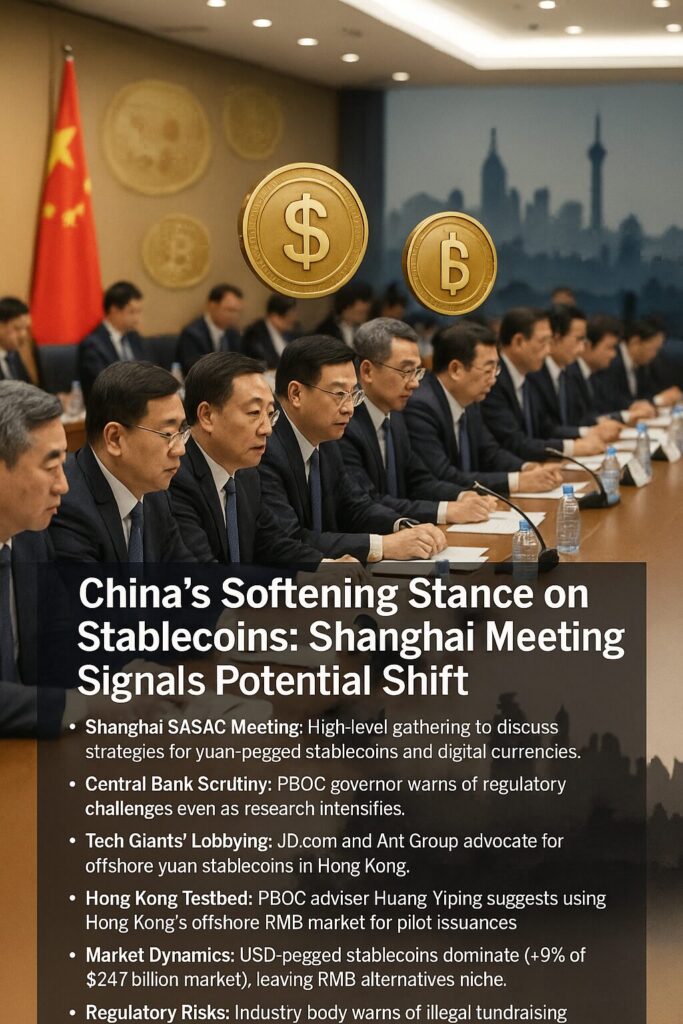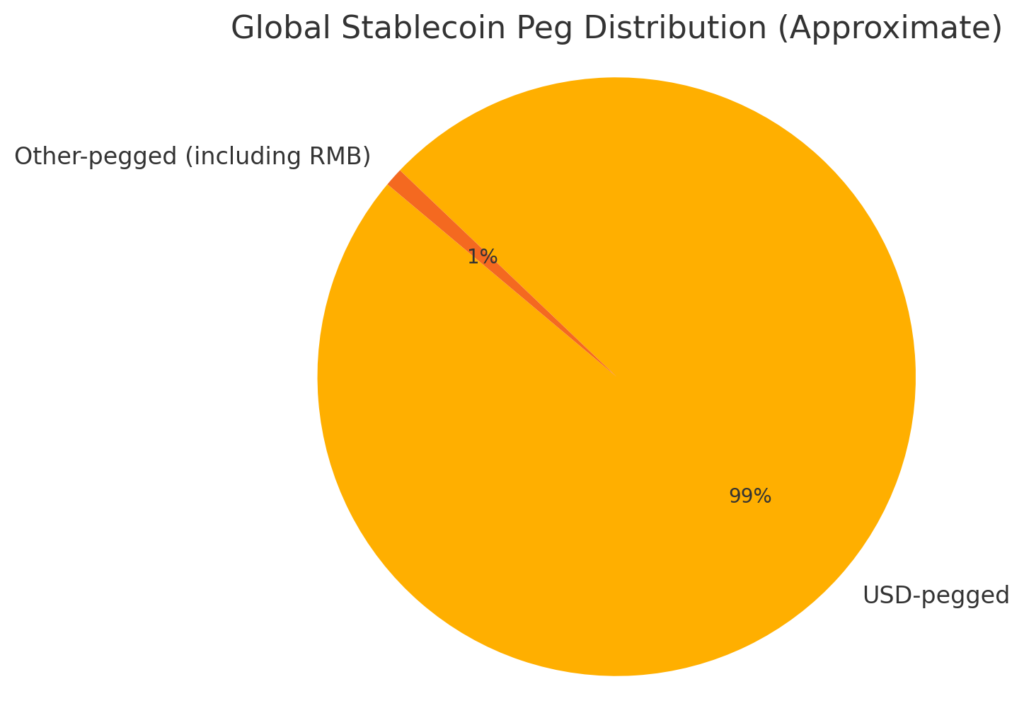
Main Points:
- Shanghai SASAC Meeting: High‐level gathering to discuss strategies for yuan‐pegged stablecoins and digital currencies.
- Central Bank Scrutiny: PBOC governor warns of regulatory challenges even as research intensifies.
- Tech Giants’ Lobbying: JD.com and Ant Group advocate for offshore yuan stablecoins in Hong Kong.
- Hong Kong Testbed: PBOC adviser Huang Yiping suggests using Hong Kong’s offshore RMB market for pilot issuances.
- Market Dynamics: USD‐pegged stablecoins dominate (99% of $247 billion market), leaving RMB alternatives niche.
- Regulatory Risks: Industry body warns of illegal fundraising in stablecoin schemes.
- FTX Fallout: U.S. court hearing on distributing refunds to Chinese creditors fuels speculation on crypto policy.
1. Shanghai SASAC Meeting: A Quiet Pivot
On July 10, Shanghai’s State-owned Assets Supervision and Administration Commission (SASAC) convened roughly 60-70 officials to “mull strategic responses to stablecoins and digital currencies” in what Reuters called a “major shift” for China’s most important financial hub. The meeting, led by SASAC director He Qing (賀青), underscored a growing willingness to study emerging blockchain technologies and potentially craft a framework for yuan-pegged stablecoins at the local level. He Qing’s follow-up post urged “heightened sensitivity to new technologies and reinforced research on digital currency”, signifying that top cadres are taking notice.
2. Central Bank’s Cautious Research Approach
While the PBOC has publicly maintained a conservative tone, Governor Pan Gongsheng (潘功勝) acknowledged in June that stablecoins and digital currencies could transform international payment systems. According to the Wall Street Journal, Pan warned of “immense regulatory challenges”, yet admitted that research into RMB‐pegged tokens is escalating. In parallel, state media Securities Times published an editorial on June 23 declaring “the sooner stablecoins are developed, the better”, reflecting a subtle policy nudge toward experimentation.
3. Tech Giants Push for Offshore RMB Tokens
Inside China’s closed crypto environment, JD.com and Ant Group have emerged as vocal proponents of a yuan-pegged stablecoin, set to launch under Hong Kong’s upcoming licensing regime on August 1. They argue that such a token could streamline trade finance for exporters and secure recurring transaction fees, ambitions long reserved for banks. As the global stablecoin market tops $247 billion, with dollar-backed tokens accounting for over 99% of issuance, these conglomerates see an opportunity to boost China’s digital currency footprint.
Global Stablecoin Peg Distribution (Approximate)

Figure: Pie chart showing USD-pegged vs. other stablecoins
4. Hong Kong as a Pilot Zone
Professor Huang Yiping, PBOC adviser and former dean at Peking University, proposed leveraging Hong Kong’s offshore RMB infrastructure as an experimental ground for a yuan-stablecoin. He noted that mainland capital controls would hinder real‐world trials, whereas Hong Kong’s free flow of offshore RMB could support a legitimate pilot. This approach aligns with broader state ambitions to internationalize the yuan in a “multi-polar currency system” and mitigate reliance on U.S. dollar rails.
5. Risks of Illegal Fundraising
China’s rapid pivot has not gone unnoticed by domestic watchdogs. On July 10, the Beijing Internet Finance Association issued a warning about “illegal fundraising risks involving stablecoins”, highlighting that unscrupulous actors are marketing high-yield schemes under the guise of innovation. This cautionary tone indicates that, despite growing official interest, regulators remain vigilant against fraud and speculation.
6. FTX Distribution Sparks Speculation
Meanwhile, the FTX bankruptcy trustee filed a motion on July 8 to freeze distributions to “restricted jurisdictions,” China among them, accounting for 82% of pending claim amounts. Over 300 Chinese creditors formally objected, asserting “China does not ban crypto holdings” . The U.S. court is set to rule on July 22, adding another twist to Beijing’s deliberations on whether to maintain a total ban or cautiously reopen regulated access.
Conclusion
China’s decades-long blanket ban on cryptocurrency trading appears to be softening—at least for stablecoins pegged to the yuan. Shanghai’s SASAC meeting represents a pivotal moment, showing local leaders eager to pilot digital currency strategies despite central bank caution. Backed by tech giants, bolstered by Hong Kong’s offshore advantages, and measured by fraud warnings, this move could mark the first tangible step toward China’s digital currency ambitions. As Beijing balances internationalization goals with financial stability, the coming months—especially Hong Kong’s August 1 licensing start—will be crucial for shaping China’s next chapter in blockchain policy.

